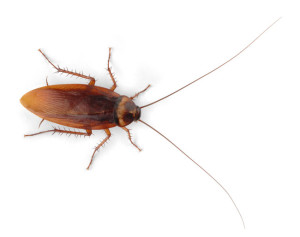Imagine for a second, you wake up hungry for a midnight snack. Quietly, you feel and bump your way down the hallway and stumble into the kitchen. It’s dark. You fumble around and manage to finally flip the switch and FLASH, out of the corner of your eye you see it—a dark, skittering, streak across the floor. A cockroach! The ultimate home invader.
According to UC Integrated Pest Management there are six species of cockroaches in California that can become pests. The German cockroach (though found in America, including California) is the one that most prefers indoor environments kept at an ideal 70°-75°, like most of our homes. A single female German cockroach can lay around 30 eggs every few weeks, causing a spread of approximately 30,000 individuals in one year, making your home into something out of a horror movie!
Although cockroaches are not known to bite or sting, they still pose a risk by carrying diseases harmful to people. The American cockroach, for example, comes into contact with garbage and human excrement in the sewer systems and may contaminate food with Salmonella if it gets into cupboards or food bins. German cockroaches are believed to be capable of transmitting diseases such as staph infections, strep throat, and even hepatitis to name a few. Roach infestations also cause an increase of allergens in the home increasing symptoms of asthma in adults and children–obviously not a good recommendation for an interspecies roommate relationship.
Does one little critter mean there is a swarm to follow? Unfortunately, the answer often is yes! Although cockroaches do not live in a supportive colony (like bees, where some would be scouts, others breeders, etc.) they do communicate through pheromones. Even if the roach is running solo, it leaves a chemical trail through feces as well as emitting airborne pheromones. These trails tell fellow cockroaches where the food, water, and ideal living quarters can be found. This will then attract many roaches, many roaches then breed, then…you get the idea!
Roaches tend to live near cracks and crevices. When traveling they tend to stay along walls and walk near the edges of the room. Very rarely would a bold, adult cockroach venture to the middle of a large room, but it might. Adults can be identified by their size (approximately the size of your thumb), and the presence of wings. Immature cockroaches are smaller and do not have wings; therefore, if you start to see young ones, chances are you have an infestation.
One thing that can be said for these pesky pests is that they are resilient. Dating back millions upon millions of years, roaches have shown staying power through the Ice Age, nuclear war, hurricanes, etc. They can live up to a month without food, two weeks without water, and even as long as 45 minutes without air. They can find sustenance in anything, including glue from the back of a postage stamp. Getting rid of them is not easy, but it is possible!
Your best first line of defense is to deny the roaches their favorite kinds of environment; warm, moist, messy ones. Following are tips from The Environmental Health Watch website for making your environment less attractive to cockroaches:
- Clean up clutter such as newspapers and piles of old clothes.
- Throw out any excess grocery bags, boxes, or crates that would make a suitable home and breeding ground.
- Be sure to seal up any cracks or holes around baseboards, sinks, shelves, and cupboards with a caulking gun.
- Clean up all food scraps from floors, tables, counters, appliances, etc. (Keep dirty dishes out of bedrooms, bathrooms, or any other rooms of the house as well.)
- Store all food in air tight containers or at least in tightly sealed packages.
- Keep garbage cans covered, and keep the garbage cans clean (even the outdoor ones.)
However, the day may come when you meet a roach invader face to face. You may have an itchy trigger finger, but DO NOT reach for the spray! Sprays and foggers are not only harmful to the health of you, your family, and your pets, they are not a permanent fix.
Traps can be useful in monitoring the presence of roaches. Borate powders and roach baits, many of which are restricted to professional use, are less dangerous and usually more effective. Because roaches are highly adaptable and tenacious, home- or business owners often end up spending hundreds of dollars on over-the-counter treatments when professional treatment would be faster and more cost-effective.
For more information about cockroaches in our Sacramento pest control region, call our experienced professionals at 916-457-7605 or visit our website at https://www.earthguardpest.com.


